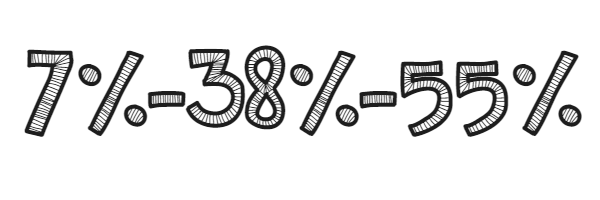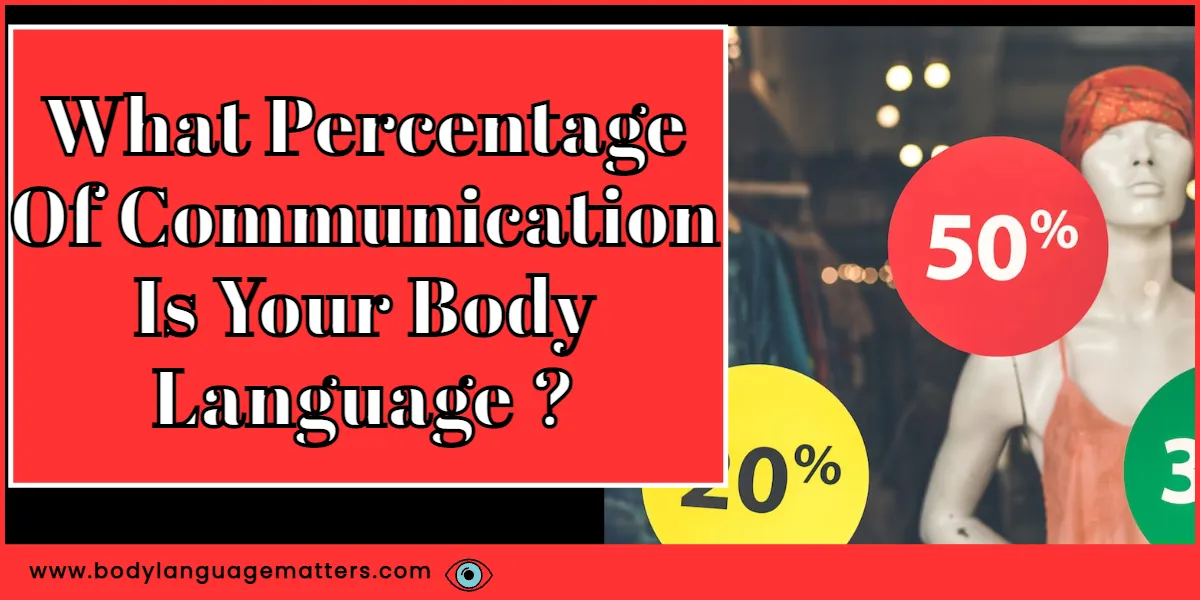There is an urban myth about the percentage of what percentage is body language or non-verbal communication. We are constantly told that 93% of our communication is non-verbal after much research and understanding that is incorrect.
According to body language experts, the percentage of nonverbal communication we use to communicate with one another is around 60% to 65%
Oftentimes, we’re told that 93% of our communication is non-verbal. If this is the case, then it should be possible to watch a television program in another language with no sound playing and understand what’s going on the moment you start watching.
Body Language Communication Study Albert Mehrabian
The 7 38 55 Rule Is A Myth

Is 93% 7% non-verbal communication rule actually true?
First, we will start by describing what this rule is for. There were a number of studies conducted in the late 1960s by a doctor named Albert Mehrabian and he was looking at non-verbal communication & the impact non-verbal communication has on it.
The data from his study showed that 55% of communication was through body language, 38% through tone, and only 7% of the actual content (the words they say)
This has become known as the 93% 7% rule because we take 55% and add 38% and that is a non-verbal piece and the verbal piece of courses remaining 7% totaling 100%.
The Problem
The study was actually pretty clear about the limitations and what the findings were. We think there is plenty of room for misinterpretation and that’s probably what happened with Mehrabian’s research and led to the 93% 7% rule.
We often hear about the 93% 7% rule about conversations and nonverbal communication, which highlights how to use nonverbal behavior to communicate effectively. For example, in presentations or at work, or in public speaking.
The problem again is that the study was not about that. The design of the research just had to do with an audience that did not know who the speaker was, as well as what he communicated in terms of content. The speakers used just one word.
What Was Measured
The study mostly measured liking, neutrality, and disliking. These are all variations of feeling rather than a wide range of emotions so you have participants who don’t know the speaker who says just one word. They are then restricted to liking or disliking the person they see.
Somehow this finding was interpreted by many to mean that 93% of all communication is nonverbal it’s just not the case.
You Can’t Believe Everything You Read, Test It.
We can test this misinterpretation of Mehrabian findings pretty easily consider for example watching a TV presenter they clearly have a visual component and an audio component to it now it’s not fair to say that you should be able to figure out what they are saying without any sound because 38% and original fining had to do with the tone let’s look at just 55% versus 45% if when they were live and the microphones went down would you be able to figurer out just from watching with no audio 55% of the message that they are trying to deliver?
You may be able to figure out something but certainly not 55% of the message they are trying to communicate the tone and the actual content of what is being said is far more important than just 45% in terms of accurately communicating a message.
Should We Ignore Non-Verbal Communication?

So does that mean that non-verbal communication is not important and this misinterpretation of early research has caused irreparable damage?
Should we ignore non-verbal communication? No not at all and rule communication is extremely important and in the original research, there was an important message that Mehrabian was trying to communicate. The message is simple it’s about incongruency.
Mehrabian was really getting out in his study in terms of finding was that when there is incongruence between non-verbal communication and verbal communication meaning someone is expressing one thing nonverbally but saying another verbally individuals pay much more attention to the non-verbal communication.
The Real Findings
That was a really important part of the study that has been overshadowed by the misinterpretation so if you want to effectively communicate and make sure that your messages is understood to make sure that your verbal communication is congruent is consistent with your verbal communication.
What Is Tone Of Voice In Communication

The tone of voice is how you convey your mood, personality, and attitude in written communication. The tone of voice may be seen as an aspect of style in which the writer is able to demonstrate her personal preferences.
There are three different aspects to the tone of voice, which are known as the “Three Tones”. These include:
1) The Attitude towards the content (positive or negative)
2) How formal or informal the writing is (formal or informal)
3) How assertive or passive (assertive or passive).
Frequently Asked Questions.
What percentage of communication is nonverbal?
Most experts now believe that around 66% of communication is nonverbal.
how much does body language affect communication?
Nonverbal cues such as facial expressions and gestures like eye contact affect body language in a big way. The way you carry yourself displays to others how you are feeling on a subconscious level. This is really important when it comes to first impressons. So it really important to understand how to act verbally and nonverbally in order to fit in with the tribe.
Final Thoughts
How much we communicate through body language has never really been truly figured out by experts like Chase Huges have stated in his book the Six Minute X-Ray rapid behavior profiling is around 66%.
The use of body language is so important because it enables us to express our feelings and emotions without relying on words and sentences which people might not understand. According to the research in this study, non-verbal communication is essential regardless of what specific number we assign to it. It’s more than half of communication and we all know that naturally. If you have enjoyed reading this post you may also enjoy reading how to read body language until next time stay safe.

